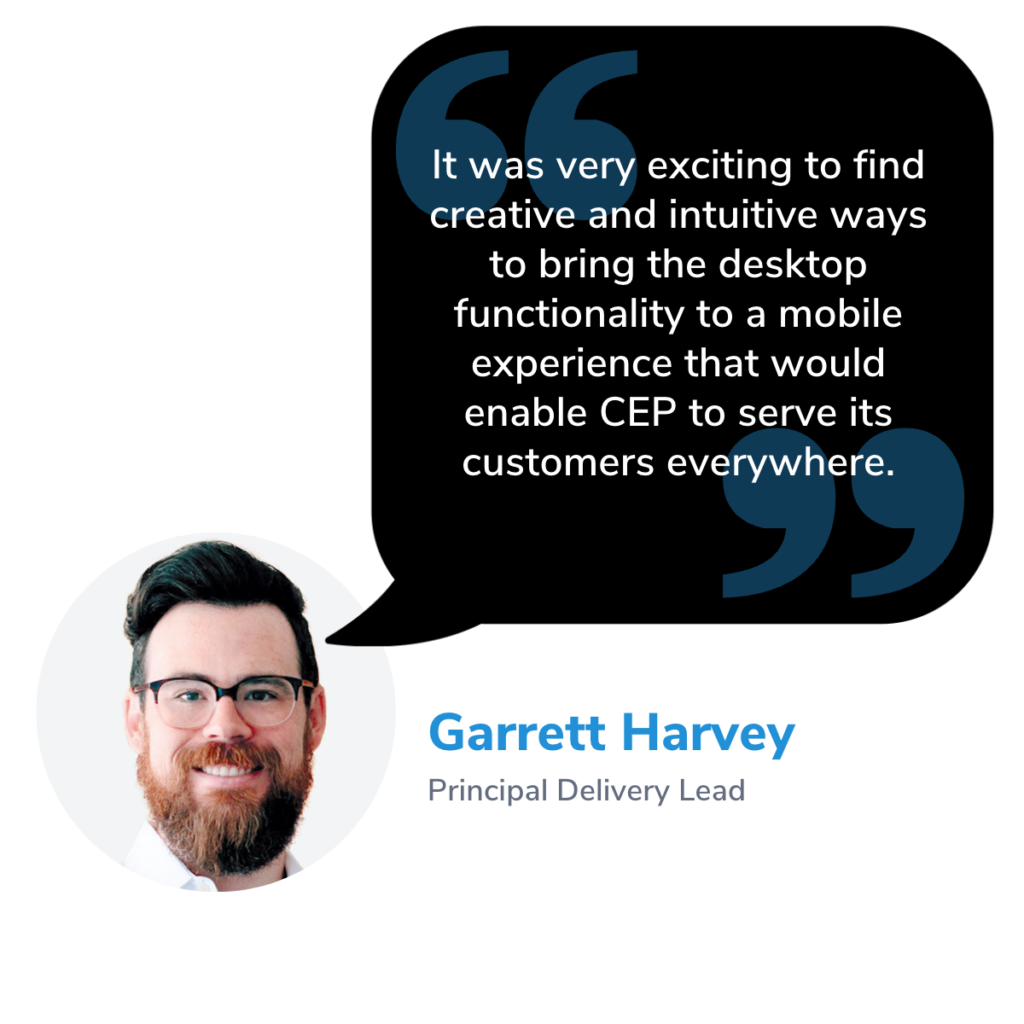
15 min read
CEP by Praxent

A financial services nonprofit goes from “We need an app,” to building trust, improving user adoption, and growing partnerships with a full UX/UI refresh and development-ready mobile app and web portal designs.
Background
“We were very early—long before our time—to adopt having a web portal for our customers. We missed ‘cep.com’ by six months, but we were right on the cutting edge, technologically, in the 90s. We got a portal out. We got a portal in place that people were using. We refreshed it several times, but we got stuck with an old platform, just an old approach to how you make the web available to people.
“And so what had been cutting edge, and easier to use than anything people had seen up to that point, was becoming—it wasn’t very friendly on the phone for our customers as they started to get mobile phones that can use websites (which was not as soon as I got a mobile phone. We have an older customer base, and so there was a little bit of a lag.) As people started using our website on things that weren’t desktops, as people started seeing really modern websites with modern accessibility features, and sort of a different approach to how you lay things out and how you make things accessible and what you do and don’t expect to be able to do, our website was starting to fall behind or had fallen behind.
“And while we had made several approaches internally to just renovating the website, we were approaching it as renovating the website. Take your existing portal, and make it mobile friendly. Take your existing portal, and just rearrange things on the phone; that was what we were looking for. And so when we had a change in leadership, about a year ago, our new president went in front of the Board and was like, ‘We’re gonna have an app.’ And they came back to me and they said, ‘We need an app,’ And I was like, ‘I’ve been working on renewing the portal.
“From the customer perspective, it’s like ‘Okay, well, my credit union, I can use it on my phone, I can have an app on my screen. I don’t have to remember their website name.’ Our users or customers were saying, ‘I can integrate my web stuff with all these other services. It is a more intuitive layout, a more intuitive interface when I’m using these other websites, and half of your website isn’t there.’ We had several people on our Board make the same observation, like, ‘How come I have to go to your website? How come I can’t just click an app on my phone?’
“And so when they said, ‘We need an app,’ I was like, ‘Do you want that or the portal that we’ve been working on for a couple years?’ We wanted [the app] right now, so I knew we couldn’t do that on our own. I had been struggling with redoing the portal forever. So I started shopping around, and I literally just started googling ‘people who make bank apps.’ I found one company in Ukraine. I found a couple of American companies. I found another company in Eastern Europe. I was just shopping around, and several of them were like, ‘Oh, yeah, we can do this,’ but really, my approach was, I need somebody who can take our existing portal and make an app out of it. Like just thinking [the app would look] like our existing portal.”
The problem
“We are in financial services, not for profit, so we’re in a weird space. There are not a lot of not-for-profit financial services companies, 501c3 charitable religious institutions, that also do loans. So it’s a weird niche, but we are handling people’s money. And there is a sense of trust that you want to be able to convey to people that we are in actuality, taking very good care of their money; we are taking very strict pains to make sure that our technologies are secure, that their data and information is secure, trying to make good use of their money. But I think having an old website, and an old design on our website, there’s an image problem there. If it’s a bodyguard who just wears shorts and a T-shirt and is sitting down, it just doesn’t project the confidence that a well-trimmed suit and sunglasses and a clean shave would.
“Where we were feeling the most pain was when we were trying to talk to potential new customers, potential new partners. … The people who worked with us, they loved us. They trusted us. They knew what we were doing. They knew we just didn’t dress well. But talking to somebody new, you’re like, ‘Hey, would you give us your money?’ And they’re like, ‘You don’t even have an app in the App Store. Your website looks like it’s from10 years ago. Are you even a real company?’ So I think that image problem of ‘We will actually take care of your money, and we are actually competent at what we do,’ there was a gap between our image and who we actually are as a company. Our Board, our new leadership agreed with our marketing team’s complaint that it’s hard to sell us as a trusted financial partner when we don’t look our best.
“I will also say that an unexpected side effect was that it did demonstrate that we had an internal need for additional investment in technology. Just the process of taking on a massive project like launching an app when we had never done that before and supporting it securely internally has really beefed up how we handle people’s data and how we handle people’s information.
“We try to never leave somebody with an automated voicemail since we have a live receptionist who transfers you to live people. All of our customers, when they need assistance, are talking to our employees in our building. And so [our staff was] feeling that drain a little bit, people who are lost or ‘I don’t know where to do this on the website,’ or ‘How come I’m locked out of my account? I don’t know how to get back in,’ and some of that no design will ever fix, but when we said we’re redoing the portal and we’re having it professionally designed, I think all of our customer service staff was like ‘Oh, thank goodness!’”
Why Praxent
“When I talked to Praxent and your marvelous sales team, they were like, ‘Okay, do you have the specifications laid out?’ and we’re a very small company. I mean, we have 36 employees right now total. And that’s across all departments and all teams. So, [Kevin was] asking for the documents that the project manager put together, and I’m like, ‘We don’t have a project manager. Here’s our website; just make that on a phone.’ He was like, ‘Okay, let me let me stop you here for a second.’
“Other people were like, ‘Sure. I’ll put your website on the phone. I don’t care, whatever, give me some money.’ But Kevin was like, ‘Before we do, let me throw something else at you. What if we design it?’ So I was also seeing very high dollar numbers from some of these development companies, [but Kevin said] ‘Designing it is going to cost a fraction of building it, but it’s going to be so much better. And you can sign up for this much smaller dollar amount to just design the thing and make sure you’re actually getting what you really need and not just what you’ve already got in a different shape.’ And I immediately was like, ‘Ah!’ internally, and then as I chewed on it, and as that sat with me, I went back to my boss and I said, ‘What if I spent a lot of extra money before we make the app?’ As we talked about it, and as we looked at Praxent’s portfolio, we just weren’t like, ‘Oh, this might be really good idea,’ it was, ‘We don’t know what we need. We don’t know that this is the best way that our current portal is going to make a good app.’ So I went from saying ‘Yeah, probably not Kevin, to okay, let’s do it. Let’s try this out. Let’s spend that money.’
“Praxent’s sales team did a really good job of laying out, ‘Here are your options for design, can you pick the package that works best for you, giving us options of how many focus groups do you want to have? How much user input do you want to have? How much time you want us to spend on this or that? That was really helpful. And it led to some very good internal conversations about, is it worth an extra $10,000 to go this versus that? I was very happy with Kevin, and I will say, I really don’t feel like there was any over promising here. What we were getting into talking to the salespeople, by the end of our experience with the implementation people or the design implementation, we were like, ‘Yes, we got exactly what we thought we were getting, plus more. It was good.”
The solution
“Working with [Praxent’s] design team … I was really impressed. As a small company, but also as a relatively self-sufficient company, we have not outsourced very much ever. This this wasn’t our first technology project that we went to a partner for, but it was the second project. So I didn’t have a lot of context because this is only my second time doing this. And the first time was pure technology implementation with zero design work put into it. I’m a technology guy. I’m not a design guy. I don’t know what you’re getting into here; I’m really needing to trust you guys to know what you’re doing. And by and large, they did.
“I feel like the designers asked a lot of really good questions. We had some really good conversations about underlying technology. They had some really good interviews with other people who work in our office. But then they just started putting out these really great designs and layouts and bringing up some ideas that we never thought about. The other thing I appreciated was conflict. … There were some places where they were saying from our professional experience, you need to do X … they were able to diplomatically assert what was going to be best for us in a way that I think helps disarm some of the opposition they were getting. … They were even able to bring that experience in and explain why this was going to be beneficial to us and our users.
“[The designs look] beautiful. … We will have forms get redesigned, internal documents, and you’ll pass it around the office to different stakeholders, and there’ll be a lot of like, ‘Can we change that?’ Honestly, Praxent’s designs compared to what we’re used to working with, across the board, every stakeholder in the office is just like, ‘Oh my gosh, this is so good. This is so good. Our stuff could look like this? This is incredible,’ which is an unusual, and I’m glad we got to have that experience, but I think it really does speak to the designers. There wasn’t a lot of like, ‘Go back and redo that. Nobody likes it.’ Very little of that. And then they were able to take those in-progress pieces of work to the Board. The board is like, ‘When we said an app, we weren’t thinking a good app like what this is! Amazing. Incredible.
“I think there’s a gap a lot of times with us non-artistic types. We know when we enjoy or appreciate something, but we don’t have the talent and skill to make something that lives up to our tastes, if that makes sense. Like I could draw something and know that I’m not happy with the drawing. But I don’t necessarily know how to draw it to the point where I would be happy with it. So I think that Praxent was able to meet or exceed our own tastes on the first go. So everybody looks at it and they’re like, ‘I didn’t know what I wanted. But it was that. I like that.’ And that was a relatively painless process. We signed up for the thing, and they just went through the iterations, and then it was just great. And there wasn’t like this whole ‘niggling’ back and forth trying to get all the stakeholders happy. Everybody was like, ‘Oh, yeah, I like that a lot. That is great. Okay, cool. I’m glad we did this.’”
The results
“The other thing Praxent did—that I now appreciate so much more because I haven’t done these projects before—when y’all delivered the final design documents, and I took those to another developer, they were actually implemented. Developers are in the middle of working on it right now. This feedback I am getting from the developers (we’re working with a team of developers that do projects for 3M, so for major, major organizations), they are saying we have never worked—ever—on a mobile project that was this well designed, or this thoroughly designed. Actually, some of them have been like, ‘This is our fun project. The designers answered all of the questions that we normally have to come back [and ask].’

been one or two little fiddly things that we still have to work out. But, literally, the designers, and it seems to be genuine, they’re like, ‘This is our fun project to work on because we never get one where it’s just do your development; the design work has been taken care of and so well laid out and all we have to do is the part we actually enjoy doing, which is the coding.’ To get that feedback from another company—again, they’re building apps for [big organizations who] ‘don’t give us this. This is a joy to work on.’
“So that has been reassuring that the money we spent with Praxent was the best investment we could have made because instead of just getting an app that works within what [the Board wanted], we’re also getting something that people are excited to see. We’re getting something that people are excited to work on. We’re getting something that people are excited to get—our marketing team is salivating now like, ‘Oh my gosh, when this goes live we’re so excited to tell people.’
“It seems like it has been so worth the money. And I think that was apparent about a week into the process, but it just continues to be great.
“All of our technologies are accelerating forward to thinking about how will we do this in the future, and this app project just spurred everything on to a thought less of, ‘How do we do the best job we can do right now?’ to ‘How do we do the best job to lay the groundwork for the future? And honestly, stepping into this app project and with Praxent’s design help and also just user experience help, has actually had that weird side effect of now we’re changing the way that we approach several other things in our company that we weren’t expecting to.”


Leave a Reply